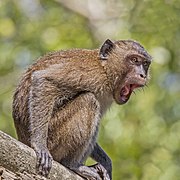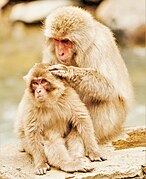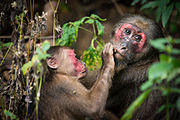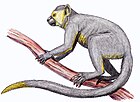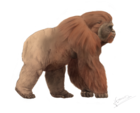Макака
| Макаки [ 1 ] | |
|---|---|

| |
| Капотная макака в Манегаоне, Махараштра , Индия | |
| Научная классификация | |
| Домен: | Эукариоты |
| Королевство: | животное |
| Тип: | Хордовые |
| Сорт: | Млекопитающие |
| Заказ: | Приматы |
| Подотряд: | Хаплорини |
| Инфрапорядок: | Симииформы |
| Семья: | Церкопитециды |
| Племя: | Галстуки-бабочки |
| Род: | Макака Ласепед , 1799 г. |
| Типовой вид | |
| Симия живет [ 1 ] | |
| Разновидность | |
|
Посмотреть текст | |
Макаки ( / m ə ˈ k ɑː k , - ˈ k æ k / ) [ 2 ] представляют собой род ( Macaca ) стадных обезьян Старого Света подсемейства Cercopithecinae . 23 вида макак обитают в Азии , Северной Африке и (в Гибралтаре ) Европе . Макаки в основном плодоядны (предпочитают фрукты), хотя в их рацион также входят семена, листья, цветы и кора деревьев. Некоторые виды, такие как длиннохвостая макака ( M. fascicleis ; также называемая макакой-крабоедом), дополняют свой рацион небольшим количеством мяса моллюсков, насекомых и мелких млекопитающих. В среднем южная макака с косичками ( M. nemestrina ) в Малайзии ежегодно съедает около 70 крупных крыс. [ 3 ] [ 4 ] Все социальные группы макак организованы вокруг доминирующих матриархов . [ 5 ]
Макаки встречаются в различных средах обитания по всему азиатскому континенту и легко адаптируются . Некоторые виды являются синантропными , поскольку научились жить рядом с людьми, но они стали проблематичными в городских районах Юго-Восточной Азии и непригодны для проживания, поскольку могут переносить инфекционные заболевания.
Большинство видов макак занесены в Красный список Международного союза охраны природы (МСОП) как уязвимые и находящиеся под угрозой исчезновения .
Описание
[ редактировать ]Помимо людей (род Homo ), макаки являются наиболее распространенным родом приматов , простирающимся от Японии до Индийского субконтинента , а в случае берберийской макаки ( Macaca sylvanus ) — до Северной Африки и Южной Европы . В настоящее время известно двадцать три вида макак. Макаки — крепкие приматы, руки и ноги которых примерно одинаковой длины. Мех этих животных обычно имеет различные оттенки коричневого или черного цвета, а их морды закруглены в профиль с ноздрями на верхней поверхности. Хвост у каждого вида различается: он может быть длинным, умеренным, коротким или полностью отсутствовать. [ 6 ] Хотя у некоторых видов отсутствуют хвосты, и их общие названия относятся к ним как к обезьянам , это настоящие обезьяны, не имеющие большего отношения к настоящим обезьянам, чем любые другие обезьяны Старого Света . Вместо этого это происходит из более раннего определения понятия «обезьяна», которое в целом включало приматов. [ 7 ]
У некоторых видов кожные складки соединяются со второго по пятый пальцы ног, почти достигая первого плюсневого сустава. [ 8 ] Размер обезьяны различается в зависимости от пола и вида. Длина головы и тела самцов всех видов может составлять от 41 до 70 см (от 16 до 28 дюймов), а вес - от 5,5 до 18 кг (от 12,13 до 39,7 фунтов). [ 6 ] Самки могут весить от 2,4 до 13 кг (от 5,3 до 28,7 фунтов). Эти приматы живут группами, различающимися по размеру, в которых доминируют самцы, однако порядок доминирования часто меняется. Женское доминирование длится дольше и зависит от их генеалогического положения. Макаки умеют плавать и большую часть времени проводят на земле, а некоторое время проводят на деревьях. На щеках у них есть большие мешки, в которые они несут дополнительную еду. Они считаются очень умными и часто используются в медицинской сфере для экспериментов из-за их удивительного сходства с людьми в эмоциональном и когнитивном развитии. Обширные эксперименты привели к тому, что длиннохвостая макака была занесена в список находящихся под угрозой исчезновения. [ 6 ]
Распространение и среда обитания
[ редактировать ]Макаки легко адаптируются к различным средам обитания и климату, могут переносить большие колебания температуры и жить в различных ландшафтных условиях. Они легко адаптируются к созданной человеком среде и могут хорошо выжить в городских условиях, если у них есть возможность добывать пищу. Они также могут выжить в совершенно естественных условиях, вдали от людей.
Экологические и географические ареалы макак самые широкие среди всех приматов, кроме человека. Их среда обитания включает влажные тропические леса Юго-Восточной Азии , Шри-Ланки , Индии , засушливые горы Пакистана и Афганистана , а также горы умеренного пояса в Алжире , Японии , Китае , Марокко и Непале . Некоторые виды также обитают в деревнях и поселках городов Азии. [ 9 ] также имеется завезенная популяция макак-резус, В американском штате Флорида состоящая, по сути, из обезьян, брошенных после того, как в середине 20 века было закрыто неудавшееся сафари на лодке.
Вероятный коренной зуб раннеплиоценовой макаки из формации Ред Крэг ( Уолдрингфилд , Великобритания) представляет собой одну из старейших и самых северных находок этого рода в Европе, о которых сообщалось на сегодняшний день. [ 10 ]
Ecology and behavior
[edit]Diet
[edit]Macaques are mainly frugivorous, although some species have been observed feeding on insects. In natural habitats, they have been observed to consume certain parts of over one hundred species of plants including the buds, fruit, young leaves, bark, roots, and flowers. When macaques live amongst people, they raid agricultural crops such as wheat, rice, or sugarcane; and garden crops like tomatoes, bananas, melons, mangos, or papayas.[11] In human settings, they also rely heavily on direct handouts from people. This includes peanuts, rice, legumes, or even prepared food.
Group structure
[edit]Macaques live in established social groups that can range from a few individuals to several hundred, as they are social animals. A typical social group possess between 20 and 50 individuals of all ages and of both sexes. The typical composition consists of 15% adult males, 35% adult females, 20% infants, and 30% juveniles, though there exists variation in structure and size of groups across populations.[citation needed]

Macaques have a very intricate social structure and hierarchy, with different classifications of despotism depending on species.[13] If a macaque of a lower level in the social chain has eaten berries and none are left for a higher-ranking macaque, then the one higher in status can, within this social organization, remove the berries from the other monkey's mouth.[14]
Reproduction and mortality
[edit]The reproductive potential of each species differs. Populations of the rhesus macaque can grow at rates of 10% to 15% per year if the environmental conditions are favorable. However, some forest-dwelling species are endangered with much lower reproductive rates.[citation needed] After one year of age, macaques move from being dependent on their mother during infancy, to the juvenile stage, where they begin to associate more with other juveniles through rough tumble and playing activities. They sexually mature between three and five years of age. Females will usually stay with the social group in which they were born; however, young adult males tend to disperse and attempt to enter other social groups. Not all males succeed in joining other groups and may become solitary, attempting to join other social groups for many years.[citation needed] Macaques have a typical lifespan of 20 to 30 years.
As invasive species
[edit]
Certain species under the genus Macaca have become invasive in certain parts of the world, while others that survive in forest habitats remain threatened. The long-tailed macaque (M. fascicularis) is listed as a threat and invasive alien species in Mauritius, along with the rhesus macaques (M. mulatta) in Florida.[15] Despite this, the former is listed as endangered.
The long-tailed macaque causes severe damage to parts of its range where it has been introduced because the populations grow unchecked due to a lack of predators.[16] On the island of Mauritius, they have created serious conservation concerns for other endemic species. They consume seeds of native plants and aid in the spread of exotic weeds throughout the forests. This changes the composition of the habitats and allows them to be rapidly overrun by invasive plants.
Long-tailed macaques are also responsible for the near extinction of several bird species on Mauritius by destroying the nests of the birds as they move through their native ranges and eat the eggs of critically endangered species, such as the pink pigeon and Mauritian green parrot.[17] They can be serious agricultural pests because they raid crops and gardens and humans often shoot the monkeys which can eliminate entire local populations.
In Florida, a group of rhesus macaques inhabit Silver Springs State Park. Humans often feed them, which may alter their movement and keep them close to the river on weekends where high human traffic is present.[15] The monkeys can become aggressive toward humans (largely due to human ignorance of macaque behavior), and also carry potentially fatal human diseases, including the herpes B virus.[18]
Relations with humans
[edit]Several species of macaque are used extensively in animal testing, particularly in the neuroscience of visual perception and the visual system.
Nearly all (73–100%) captive rhesus macaques are carriers of the herpes B virus. This virus is harmless to macaques, but infections of humans, while rare, are potentially fatal, a risk that makes macaques unsuitable as pets.[19]
Urban performing macaques also carried simian foamy virus, suggesting they could be involved in the species-to-species jump of similar retroviruses to humans.[20]
Population control
[edit]Management techniques have historically been controversial, and public disapproval can hinder control efforts. Previously, efforts to remove macaque individuals were met with public resistance.[15] One management strategy that is currently being explored is that of sterilization. Natural resource managers are being educated by scientific studies in the proposed strategy. Effectiveness of this strategy is estimated to succeed in keeping populations in check. For example, if 80% of females are sterilized every five years, or 50% every two years, it could effectively reduce the population.[15] Other control strategies include planting specific trees to provide protection to native birds from macaque predation, live trapping, and the vaccine porcine zona pellucida (PZP), which causes infertility in females.[17]
Cloning
[edit]In January 2018, scientists in China reported in the journal Cell the first creation of two crab-eating macaque clones, named Zhong Zhong and Hua Hua, using somatic cell nuclear transfer – the same method that produced Dolly the sheep.[21][22][23][24]
Species
[edit]| Common name | Scientific name and subspecies | Range | Size and ecology | IUCN status and estimated population |
|---|---|---|---|---|
| Toque macaque | M. sinica (Linnaeus, 1771) Three subspecies
|
Sri Lanka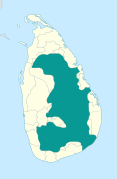
|
Size: 36–53 cm (14–21 in) long, plus at least 36–53 cm (14–21 in) tail[25] Habitat: Forest[26] Diet: Fruit as well as tree flowers, buds, and leaves[27] |
EN
|
| Arunachal macaque | M. munzala Sinha, Datta, Madhusudan, Mishra, 2005 |
Eastern Himalayas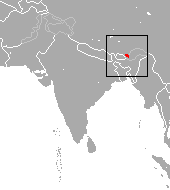
|
Size: 36–77 cm (14–30 in) long, plus about 9–20 cm (4–8 in) tail[25] Habitat: Forest[28] Diet: Fruit, leaves, grains, buds, seeds, flowers, and bark, as well as insects and small invertebrates[25] |
EN
|
| Assam macaque | M. assamensis (McClelland, 1840) Two subspecies
|
Southeastern Asia
|
Size: 36–77 cm (14–30 in) long, plus about 9–20 cm (4–8 in) tail[25] Habitat: Forest[29] Diet: Fruit, leaves, grains, buds, seeds, flowers, and bark, as well as insects and small invertebrates[25] |
NT
|
| Barbary macaque | M. sylvanus (Linnaeus, 1758) |
Northwestern Africa
|
Size: 45–60 cm (18–24 in) long, plus 1–2 cm (0–1 in) tail[30] Habitat: Forest, shrubland, grassland, rocky areas, and caves[31] Diet: Plants, caterpillars, fruit, seeds, roots, and fungi[30] |
EN
|
| Bonnet macaque | M. radiata (Geoffroy, 1812) Two subspecies
|
Southern India
|
Size: 36–77 cm (14–30 in) long, plus about 9–20 cm (4–8 in) tail[25] Habitat: Forest, savanna, and shrubland[32] Diet: Fruit, foliage, and insects, as well as bird eggs and lizards[33] |
VU
|
| Booted macaque | M. ochreata (Ogilby, 1841) |
Island of Sulawesi in Indonesia
|
Size: 36–77 cm (14–30 in) long, plus about 1–15 cm (0–6 in) tail[25] Habitat: Forest and savanna[34] Diet: Fruit, leaves, grains, buds, seeds, flowers, and bark, as well as insects and small invertebrates[25] |
VU
|
| Celebes crested macaque | M. nigra (Desmarest, 1822) |
Island of Sulawesi
|
Size: 44–57 cm (17–22 in) long, plus about 2 cm (1 in) tail[35] Habitat: Forest[36] Diet: Fruit, as well as insects, shoots, leaves, and stems[35] |
CR
|
| Crab-eating macaque | M. fascicularis (Raffles, 1821) Ten subspecies |
Southeastern Asia
|
Size: 40–47 cm (16–19 in) long, plus 50–60 cm (20–24 in) tail Habitat: Forest, intertidal marine, caves, inland wetlands, grassland, shrubland, and savanna[37] Diet: Fruit, crabs, flowers, insects, leaves, fungi, grasses, and clay[38] |
EN
|
| Formosan rock macaque | M. cyclopis Swinhoe, 1862 |
Taiwan
|
Size: 36–45 cm (14–18 in) long, plus 26–46 cm (10–18 in) tail[39] Habitat: Forest[40] Diet: Fruit, leaves, berries, seeds, insects, and small vertebrates, buds, and shoots[39] |
LC
|
| Gorontalo macaque | M. nigrescens (Temminck, 1849) |
Island of Sulawesi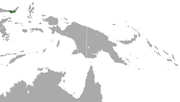
|
Size: 36–77 cm (14–30 in) long, plus about 1–15 cm (0–6 in) tail[25] Habitat: Forest[41] Diet: Fruit, leaves, grains, buds, seeds, flowers, and bark, as well as insects and small invertebrates[25] |
VU
|
| Heck's macaque | M. hecki (Matschie, 1901) |
Island of Sulawesi
|
Size: 36–77 cm (14–30 in) long, plus about 1–15 cm (0–6 in) tail[25] Habitat: Forest and grassland[42] Diet: Fruit, leaves, grains, buds, seeds, flowers, and bark, as well as insects and small invertebrates[25] |
VU
|
| Japanese macaque | M. fuscata (Blyth, 1875) Two subspecies
|
Japan
|
Size: 36–77 cm (14–30 in) long, plus about 1–15 cm (0–6 in) tail[25] Habitat: Forest[43] Diet: Fruit, seeds, flowers, nectar, leaves, and fungi[44] |
LC
|
| Lion-tailed macaque | M. silenus (Linnaeus, 1758) |
Southwestern India
|
Size: 40–61 cm (16–24 in) long, plus 24–38 cm (9–15 in) tail[45] Habitat: Forest[46] Diet: Fruit, as well as leaves, stems, flowers, buds, fungi, insects, lizards, tree frogs, and small mammals[45] |
EN
|
| Moor macaque | M. maura (Schinz, 1825) |
Island of Sulawesi
|
Size: 36–77 cm (14–30 in) long, plus about 1–15 cm (0–6 in) tail[25] Habitat: Forest and grassland[47] Diet: Fruit, leaves, grains, buds, seeds, flowers, and bark, as well as insects and small invertebrates[25] |
EN
|
| Muna-Buton macaque
|
M. brunnescens (Matschie, 1901) |
Island of Sulawesi in Indonesia
|
Size: 36–77 cm (14–30 in) long, plus about 1–15 cm (0–6 in) tail[25] Habitat: Forest[48] Diet: Fruit, leaves, grains, buds, seeds, flowers, and bark, as well as insects and small invertebrates[25] |
VU
|
| Northern pig-tailed macaque | M. leonina (Blyth, 1863) |
Southeastern Asia
|
Size: 36–77 cm (14–30 in) long, plus about 9–20 cm (4–8 in) tail[25] Habitat: Forest[49] Diet: Leaves, seeds, stems, roots, flowers, bamboo shoots, rice, gums, insects, larvae, termite eggs and spiders[49] |
VU
|
| Pagai Island macaque | M. pagensis (G. S. Miller, 1903) |
Mentawai Islands in Indonesia
|
Size: 36–77 cm (14–30 in) long, plus about 9–20 cm (4–8 in) tail[25] Habitat: Forest[50] Diet: Fruit, leaves, grains, buds, seeds, flowers, and bark, as well as insects and small invertebrates[25] |
CR
|
| Rhesus macaque | M. mulatta (Zimmermann, 1790) |
Southern and southeastern Asia
|
Size: 45–64 cm (18–25 in) long, plus 19–32 cm (7–13 in) tail[51] Habitat: Forest, savanna, and shrubland[52] Diet: Fish, crabs, shellfish, bird eggs, honeycombs, crayfish, crabs, spiders, plants, gums and pith[52] |
LC
|
| Siberut macaque
|
M. siberu Fuentes, 1995 |
Siberut island in Indonesia
|
Size: 36–77 cm (14–30 in) long, plus about 9–20 cm (4–8 in) tail[25] Habitat: Forest[53] Diet: Fruit, as well as mushrooms, leaves, crabs, crayfish, pith, sap, shoots and flowers[53] |
EN
|
| Southern pig-tailed macaque | M. nemestrina (Linnaeus, 1766) |
Southeastern Asia
|
Size: 46–57 cm (18–22 in) long, plus 13–26 cm (5–10 in) tail[54] Habitat: Forest and shrubland[55] Diet: Fruit, insects, seeds, leaves, dirt, and fungus, as well as birds, termite eggs and larvae, and river crabs[54] |
EN
|
| Stump-tailed macaque | M. arctoides (I. Geoffroy, 1831) |
Southeastern Asia
|
Size: 48–65 cm (19–26 in) long, plus 3–7 cm (1–3 in) tail[56] Habitat: Forest[57] Diet: Fruit, seeds, flowers, roots, leaves, frogs, crabs, birds, and bird eggs[56] |
VU
|
| Tibetan macaque | M. thibetana (A. Milne-Edwards, 1870) Four subspecies
|
East China
|
Size: 36–77 cm (14–30 in) long, plus about 1–15 cm (0–6 in) tail[25] Habitat: Forest and caves[58] Diet: Fruit, as well as flowers, berries, seeds, leaves, stems, stalks, and invertebrates[58] |
NT
|
| Tonkean macaque | M. tonkeana (von Meyer, 1899) |
Island of Sulawesi
|
Size: 36–77 cm (14–30 in) long, plus about 1–15 cm (0–6 in) tail[25] Habitat: Forest[59] Diet: Fruit, leaves, grains, buds, seeds, flowers, and bark, as well as insects and small invertebrates[25] |
VU
|
| White-cheeked macaque | M. leucogenys Li, Zhao, Fan, 2015 |
Northeastern India | Size: 36–77 cm (14–30 in) long, plus about 9–20 cm (4–8 in) tail[25] Habitat: Forest[60] Diet: Fruit, leaves, grains, buds, seeds, flowers, and bark, as well as insects and small invertebrates[25] |
EN
|
Prehistoric (fossil) species
[edit]- M. anderssoni Schlosser, 1924
- M. jiangchuanensis Pan et al., 1992[61]
- M. libyca Stromer, 1920
- M. majori Schaub & Azzaroli in Comaschi Caria, 1969 (sometimes included in M. sylvanus)
- M. florentina Cocchi, 1872
See also
[edit]References
[edit]- ^ Jump up to: a b Groves, C. P. (2005). Wilson, D. E.; Reeder, D. M. (eds.). Mammal Species of the World: A Taxonomic and Geographic Reference (3rd ed.). Baltimore: Johns Hopkins University Press. pp. 161–165. ISBN 0-801-88221-4. OCLC 62265494.
- ^ "macaque". Lexico UK English Dictionary. Oxford University Press. Archived from the original on October 24, 2021.
- ^ Keach, Sean (October 22, 2019). "Rat-eating monkeys in Malaysia stun scientists". The Sun.
- ^ Guy, Jack (October 22, 2019). "Rat-eating macaques could boost palm oil sustainability in Malaysia". CNN.
- ^ Fleagle, John G. (8 March 2013). Primate Adaptation and Evolution. Academic. p. 123. ISBN 978-0-12-378633-3.
- ^ Jump up to: a b c "macaque | Classification & Facts". Encyclopedia Britannica. Retrieved 2018-07-02.
- ^ "ape, n." OED Online. Oxford University Press, March 2017. Web. 16 April 2017.
- ^ Ankel-Simons, Friderun (2000). "Hands and Feet". Primate anatomy: an introduction. Academic Press. p. 340. ISBN 978-0-12-058670-7.
- ^ Knight, John (August 1999). "Monkeys on the Move: The Natural Symbolism of People-Macaque Conflict in Japan". The Journal of Asian Studies. 58 (3): 622–647. doi:10.2307/2659114. ISSN 0021-9118. JSTOR 2659114. S2CID 143569917.
- ^ Pickford, M.; Gommery, D.; Ingicco, T. (2023). "Macaque molar from the Red Crag Formation, Waldringfield, England". Fossil Imprint. 79 (1): 26–36. doi:10.37520/fi.2023.003. S2CID 265089167.
- ^ "Primate Factsheets: Long-tailed macaque (Macaca fascicularis) Conservation". pin.primate.wisc.edu. Retrieved 2018-07-02.
- ^ Boussaoud, D.; Tanné-Gariépy, J.; Wannier, T.; Rouiller, E. M. (2005). "Callosal connections of dorsal versus ventral premotor areas in the macaque monkey: A multiple retrograde tracing study". BMC Neuroscience. 6: 67. doi:10.1186/1471-2202-6-67. PMC 1314896. PMID 16309550.
- ^ Matsumura, S (1999). "The evolution of "egalitarian" and "despotic" social systems among macaques". Primates. 40 (1): 23–31. doi:10.1007/BF02557699. PMID 23179529. S2CID 23652944 – via SpringerLink Journals.
- ^ David Attenborough (2003). The Life of Mammals. BBC Video.
- ^ Jump up to: a b c d "Mapping Macaques: Studying Florida's Non-Native Primates". UF/IFAS Wildlife Ecology and Conservation Department. 2016-12-20. Retrieved 2018-07-02.
- ^ "Primate Factsheets: Long-tailed macaque (Macaca fascicularis) Conservation". pin.primate.wisc.edu. Retrieved 2018-07-02.
- ^ Jump up to: a b "GISD". iucngisd.org. Upane. Retrieved 2018-07-02.
- ^ Ostrowski, Stephanie (March 1998). "B-virus from Pet Macaque Monkeys: An Emerging Threat in the United States?". Emerging Infectious Diseases. 4 (1): 117–21. doi:10.3201/eid0401.980117. ISSN 1080-6040. PMC 2627675. PMID 9452406.
- ^ Ostrowski, Stephanie R.; et al. (1998). "B-virus from Pet Macaque Monkeys: an Emerging Threat in the United States?". Emerging Infectious Diseases. 4 (1). Centers for Disease Control and Prevention (CDC): 117–121. doi:10.3201/eid0401.980117. PMC 2627675. PMID 9452406.
- ^ "News | University of Toronto". www.utoronto.ca. Archived from the original on March 22, 2006. Retrieved May 30, 2020.
- ^ Liu, Zhen; et al. (24 January 2018). "Cloning of Macaque Monkeys by Somatic Cell Nuclear Transfer". Cell. 172 (4): 881–887.e7. doi:10.1016/j.cell.2018.01.020. PMID 29395327.
- ^ Normile, Dennis (24 January 2018). "These monkey twins are the first primate clones made by the method that developed Dolly". Science. doi:10.1126/science.aat1066. Retrieved 24 January 2018.
- ^ Briggs, Helen (24 January 2018). "First monkey clones created in Chinese laboratory". BBC News. Retrieved 24 January 2018.
- ^ "Scientists Successfully Clone Monkeys; Are Humans Up Next?". The New York Times. Associated Press. 24 January 2018. Retrieved 24 January 2018.
- ^ Jump up to: a b c d e f g h i j k l m n o p q r s t u v w x y z Nowak 1999, pp. 140, 142
- ^ Jump up to: a b Dittus, W.; Watson, A. C. (2020). "Macaca sinica". IUCN Red List of Threatened Species. 2020: e.T12560A17951229. doi:10.2305/IUCN.UK.2020-2.RLTS.T12560A17951229.en.
- ^ Kanelos, Matthew (2009). "Macaca sinica". Animal Diversity Web. University of Michigan. Archived from the original on June 7, 2023. Retrieved July 24, 2023.
- ^ Jump up to: a b Kumar, A.; Sinha, A.; Kumar, S. (2020). "Macaca munzala". IUCN Red List of Threatened Species. 2020: e.T136569A17948833. doi:10.2305/IUCN.UK.2020-2.RLTS.T136569A17948833.en.
- ^ Jump up to: a b Boonratana, R.; Chalise, M.; Htun, S.; Timmins, R. J. (2020). "Macaca assamensis". IUCN Red List of Threatened Species. 2020: e.T12549A17950189. doi:10.2305/IUCN.UK.2020-2.RLTS.T12549A17950189.en.
- ^ Jump up to: a b Jinn, Judy (2011). "Macaca sylvanus". Animal Diversity Web. University of Michigan. Archived from the original on July 24, 2023. Retrieved July 24, 2023.
- ^ Jump up to: a b Wallis, J.; Benrabah, M. E.; Pilot, M.; Majolo, B.; Waters, S. (2020). "Macaca sylvanus". IUCN Red List of Threatened Species. 2020: e.T12561A50043570. doi:10.2305/IUCN.UK.2020-2.RLTS.T12561A50043570.en.
- ^ Jump up to: a b Singh, M.; Kumara, H. N.; Kumar, A. (2020). "Macaca radiata". IUCN Red List of Threatened Species. 2020: e.T12558A17951596. doi:10.2305/IUCN.UK.2020-2.RLTS.T12558A17951596.en.
- ^ Brown, Monica (2008). "Macaca radiata". Animal Diversity Web. University of Michigan. Archived from the original on April 1, 2023. Retrieved August 16, 2023.
- ^ Jump up to: a b Riley, E.; Lee, R.; Sangermano, F.; Cannon, C.; Shekelle, M. (2021). "Macaca ochreata". IUCN Red List of Threatened Species. 2021: e.T39793A17985872. doi:10.2305/IUCN.UK.2021-1.RLTS.T39793A17985872.en.
- ^ Jump up to: a b Bichell, Rae Ellen (2011). "Macaca nigra". Animal Diversity Web. University of Michigan. Archived from the original on July 24, 2023. Retrieved July 24, 2023.
- ^ Jump up to: a b Lee, R.; Riley, E.; Sangermano, F.; Cannon, C.; Shekelle, M. (2020). "Macaca nigra". IUCN Red List of Threatened Species. 2020: e.T12556A17950422. doi:10.2305/IUCN.UK.2020-3.RLTS.T12556A17950422.en.
- ^ Jump up to: a b Hansen, M. F.; Ang, A.; Trinh, T. T. H.; Sy, E.; Paramasivam, S.; Ahmed, T.; Dimalibot, J.; Jones-Engel, L.; Ruppert, N.; Griffioen, C.; Lwin, N.; Phiapalath, P.; Gray, R.; Kite, S.; Doak, N.; Nijman, V.; Fuentes, A.; Gumert, M. D. (2022) [amended version of 2022 assessment]. "Macaca fascicularis". IUCN Red List of Threatened Species. 2022: e.T12551A221666136. doi:10.2305/IUCN.UK.2022-2.RLTS.T12551A221666136.en.
- ^ Bonadio, Christopher (2000). "Macaca fascicularis". Animal Diversity Web. University of Michigan. Archived from the original on August 12, 2023. Retrieved July 24, 2023.
- ^ Jump up to: a b Chiu, Crystal (2001). "Macaca cyclopis". Animal Diversity Web. University of Michigan. Archived from the original on August 30, 2023. Retrieved July 24, 2023.
- ^ Jump up to: a b Wu, H.; Long, Y. (2020). "Macaca cyclopis". IUCN Red List of Threatened Species. 2020: e.T12550A17949875. doi:10.2305/IUCN.UK.2020-2.RLTS.T12550A17949875.en.
- ^ Jump up to: a b Lee, R.; Riley, E.; Sangermano, F.; Cannon, C.; Shekelle, M. (2020). "Macaca nigrescens". IUCN Red List of Threatened Species. 2020: e.T12568A17948400. doi:10.2305/IUCN.UK.2020-3.RLTS.T12568A17948400.en.
- ^ Jump up to: a b Lee, R.; Riley, E.; Sangermano, F.; Cannon, C.; Shekelle, M. (2020). "Macaca hecki". IUCN Red List of Threatened Species. 2020: e.T12570A17948969. doi:10.2305/IUCN.UK.2020-3.RLTS.T12570A17948969.en.
- ^ Jump up to: a b Watanabe, K.; Tokita, K. (2021) [errata version of 2020 assessment]. "Macaca fuscata". IUCN Red List of Threatened Species. 2020: e.T12552A195347803. doi:10.2305/IUCN.UK.2020-2.RLTS.T12552A195347803.en.
- ^ hardman, brandon (2011). "Macaca fuscata". Animal Diversity Web. University of Michigan. Archived from the original on August 12, 2023. Retrieved July 24, 2023.
- ^ Jump up to: a b Стродер, Николь (2001). « Макака силенус » . Сеть разнообразия животных . Мичиганский университет . Архивировано из оригинала 12 августа 2023 года . Проверено 24 июля 2023 г.
- ^ Jump up to: а б Сингх, М.; Кумар, А.; Кумара, Х.Н. (2020). « Макака силенус » . Красный список исчезающих видов МСОП . 2020 : e.T12559A17951402. doi : 10.2305/IUCN.UK.2020-2.RLTS.T12559A17951402.en .
- ^ Jump up to: а б Райли, Э.; Ли, Р.; Сангермано, Ф.; Кэннон, К.; Шекеле, М. (2021) [ошибочная версия оценки 2020 года]. « Макака маура » . Красный список исчезающих видов МСОП . 2020 : e.T12553A197831931. doi : 10.2305/IUCN.UK.2020-3.RLTS.T12553A197831931.en .
- ^ Jump up to: а б Ли, Р.; Райли, Э.; Сангермано, Ф.; Кэннон, К.; Шекеле, М. (2021). « Макака брюнесценс » . Красный список исчезающих видов МСОП . 2021 : e.T12569A17985924. doi : 10.2305/IUCN.UK.2021-1.RLTS.T12569A17985924.en .
- ^ Jump up to: а б с Бунратана, Р.; Четри, Д.; Юнчэн, Л.; Цзян, X.-L.; Хтун, С.; Тимминс, Р.Дж. (2022 г.) [исправленная версия оценки 2020 г.]. « Макака Леонина » . Красный список исчезающих видов МСОП . 2022 : e.T39792A217754289. doi : 10.2305/IUCN.UK.2022-1.RLTS.T39792A217754289.en .
- ^ Jump up to: а б Сетиаван, А.; Миттермайер, РА; Уиттакер, Д. (2020). « Макака пагенсис » . Красный список исчезающих видов МСОП . 2020 : e.T39794A17949995. doi : 10.2305/IUCN.UK.2020-2.RLTS.T39794A17949995.en .
- ^ Сейнфельд, Джошуа (2000). « Макака мулатта » . Сеть разнообразия животных . Мичиганский университет . Архивировано из оригинала 16 августа 2023 года . Проверено 16 августа 2023 г.
- ^ Jump up to: а б с Сингх, М.; Кумар, А.; Кумара, Х.Н. (2020). « Макака мулатта » . Красный список исчезающих видов МСОП . 2020 : e.T12554A17950825. doi : 10.2305/IUCN.UK.2020-2.RLTS.T12554A17950825.en .
- ^ Jump up to: а б с Трэхольт, К.; Сетиаван, А.; Квинтен, М; Чейн, С.М.; Уиттакер, Д.; Миттермайер, РА (2020). « Макака Сиберу » . Красный список исчезающих видов МСОП . 2020 : e.T39795A17949710. doi : 10.2305/IUCN.UK.2020-2.RLTS.T39795A17949710.en .
- ^ Jump up to: а б Айерс, Кайла; Вандерпол, Кэндис (2009). « Макака Неместрина » . Сеть разнообразия животных . Мичиганский университет . Архивировано из оригинала 15 апреля 2023 года . Проверено 16 августа 2023 г.
- ^ Jump up to: а б Руперт, Н.; Хольцнер, А.; Хансен, МФ; Анг, А.; Джонс-Энгель, Л. (2022). « Макака Неместрина » . Красный список исчезающих видов МСОП . 2022 : e.T12555A215350982. doi : 10.2305/IUCN.UK.2022-1.RLTS.T12555A215350982.en .
- ^ Jump up to: а б Эрфурт, Шарлотта (2008). « Макака арктоидес » . Сеть разнообразия животных . Мичиганский университет . Архивировано из оригинала 24 июля 2023 года . Проверено 24 июля 2023 г.
- ^ Jump up to: а б Четри, Д.; Бунратана, Р.; Дас, Дж.; Лонг, Ю.; Хтун, С.; Тимминс, Р.Дж. (2020). « Макака арктоидес » . Красный список исчезающих видов МСОП . 2020 : e.T12548A185202632. doi : 10.2305/IUCN.UK.2020-3.RLTS.T12548A185202632.en .
- ^ Jump up to: а б с Юнчэн, Л.; Ричардсон, М. (2020). « Макака тибетана » . Красный список исчезающих видов МСОП . 2020 : e.T12562A17948236. doi : 10.2305/IUCN.UK.2020-2.RLTS.T12562A17948236.en .
- ^ Jump up to: а б Райли, Э.; Ли, Р.; Сангермано, Ф.; Кэннон, К.; Шекеле, М. (2020). « Макака тонкеана » . Красный список исчезающих видов МСОП . 2020 : e.T12563A17947990. doi : 10.2305/IUCN.UK.2020-3.RLTS.T12563A17947990.en .
- ^ Jump up to: а б Фан, ПФ; Ма, К. (2022). « Макака лейкогенис » . Красный список исчезающих видов МСОП . 2022 : e.T205889816A205890248. doi : 10.2305/IUCN.UK.2022-1.RLTS.T205889816A205890248.en .
- ^ Хартвиг, Уолтер Карл (2002). Летопись окаменелостей приматов . Издательство Кембриджского университета . п. 273. ИСБН 978-0-521-66315-1 .
Источники
[ редактировать ]- Новак, Рональд М. (1999). Приматы мира Уокера . Издательство Университета Джонса Хопкинса . ISBN 978-0-8018-6251-9 .
Внешние ссылки
[ редактировать ]![]() Данные, относящиеся к макакам, в Wikispecies
Данные, относящиеся к макакам, в Wikispecies







